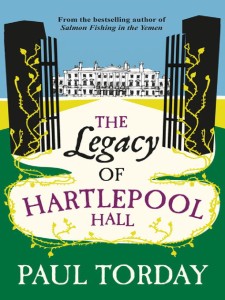I’m going to get the poor opinion I had of Paul Torday’s The Legacy of Hartlepool Hall out in the open straight away: fortunately, the fact that I found it a 1/5 star read makes a change from all my positive reviews so far; unfortunately, despite its setting, it has nothing insightful to say about County Durham.

The Legacy of Hartlepool Hall, Paul Torday
In fact, the setting of this book seems distinctly unimportant and even ambiguous: we never get closer to the truth than that the Simmonds family – aristocratic Marquesses of Hartlepool – live somewhere “on the borders of Durham and Yorkshire” (4), in the “middle of nowhere” (7). The ‘north of England’ is mentioned offhandedly on a few occasions, but otherwise the minimal commentary Torday offers of the local landscape and way of life is extremely generalised and unfulfilling. I was surprised by the lack of attention given to basic descriptions of the story’s environments, especially as much of the plot focusses on the presence of strangers or “interloper[s]” (11) who, supposedly, see everything with fresh eyes.
The story centres on the character of Ed Simmonds, who returns from a villa in France to claim his inheritance – “the large Hartlepool estate and its enormous house” (4) left to him by his deceased father – only to find that the economic tide has turned and he is virtually bankrupt, with no means to keep up his ancestral palace. He is forced to sell it to a development corporation who plan to turn the building into a block of flats. Meanwhile, several unnecessary and completely irrelevant subplots emerge: Ed has a strange Lady Alice come to stay and must also fend off the attentions of his old and issue-riddled friend Annabel.
I suppose the point of the book boils down to the fall of the English aristocracy in the modern world, shown by Ed’s human decay – into “a man who was all grey: bloodless skin, grey hair, a man whose life was draining out of him” (80) – as well as that of Hartlepool Hall, “a house that represented everything that was great, that was imperial, that was commercial” (279) but that is now no more than “a joint on the butcher’s slab, waiting to be carved up” (130) into flats. The upper-class way of life is struggling to adapt to the modern consumerist world; Annabel, for example, finds herself “trying not to be distracted by the football match on the enormous TV” while she is trying to uphold her traditional respectability by “embroidering a tapestry cushion” (21). Similarly, the fairytale ending she dreams for herself has no mention of swords or stallions but, instead, her knight possesses a “Rolls-Royce and [a] Blackberry winking its red light” (19). Basically, think Downton Abbey but with “Nescafé” (200) and food from “Marks and Spencer’s finest” (211) range.
I wouldn’t have disliked this book so much if it had had something else – anything else – to offer, but there is nothing remotely interesting or original about it. The plot is simply all over the place, with too many far-fetched things going on. Despite this, somehow it still manages to seem slow and dull – that’s a real feat. Most frustratingly of all, there are just not enough descriptions of Hartlepool Hall to make us mourn its loss or even to make the ending remotely meaningful, so the whole point of the book is completely lost. Nor is there any flow; the whole novel is a mishmash of different scenes, characters and elements of the plot that seem to bear little relation to each other. Overall, I wouldn’t bother, if I were you. It’s bizarre. Just bizarre.
Next week I’m reading Only One Way by Jannicke Howard for North Yorkshire. Get reading so I can hear your feedback!
